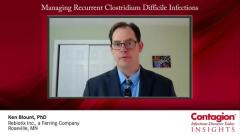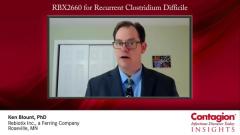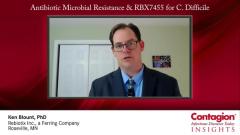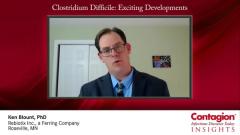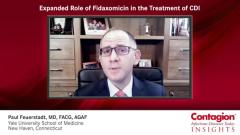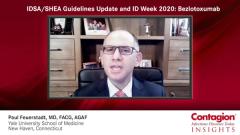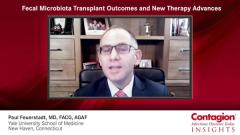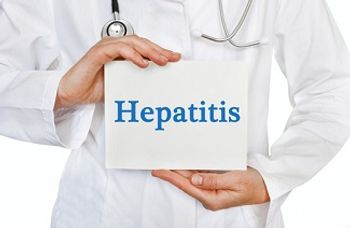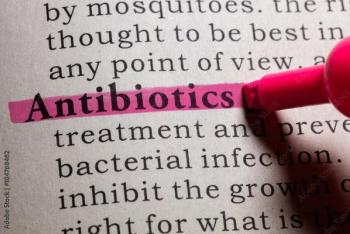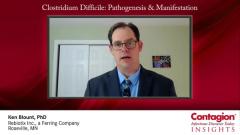
Antibiotic Microbial Resistance & RBX7455 for C Diff
Episodes in this series

Transcript:
Ken Blount, PhD: We live in a society where it’s recognized that antimicrobial resistance is increasing. It’s proliferating, it’s being spread. Any options like a microbiota restoration treatment that would allow us to get away from more and more antibiotic usage does have the potential to reduce the spread of antimicrobial resistance.
We also know that in this patient population that is afflicted with C diff [Clostridioides difficile], they’ve had an awful lot of antibiotics. Whatever they had originally that required them to have the antibiotic that stimulated the first C diff, in addition to the treatments with antibiotics they had for the C diff, this breeds antimicrobial resistant bugs, therefore, many of these patients are colonized in their gut with bacteria that carry resistance to various antibiotics. We were interested in looking at that in all our trials.
The trial that we talked about at ID [Infectious Diseases] Week 2020 was a different investigational product. It’s called RBX7455. In addition to RBX2660, this was a formulation we developed to be orally administered.
It’s a very interesting capsule in that it has some characteristics that are amenable to the patient. The number 1 being that it’s not frozen. It doesn’t have to be stored in the freezer. What that means is that participants or patients could come to the clinic, receive their first treatment, take it home, and self-administer outside of a health care setting. That’s exciting to us, and we were excited in this trial to test that. We’ve published the clinical findings from this trial.
This was a trial that was investigator-sponsored. It was a phase 1 trial conducted by Sahil Khanna, [MBBS, MS] at the Mayo Clinic in Rochester, Minnesota. It was an open-label trial designed to test 3 different dose ranges of RBX7455 in patients with recurrent C diff.
All 3 doses had equivalent efficacy, an average of 90% recurrence free at 8 weeks after the last received treatment. That was also highly consistent with our other trials in which we saw a benefit for reducing CDI [Clostridioides difficile infection] recurrence. The lowest dose in that trial that we administered was 2 capsules twice a day for 2 days. To me, that sounds much more like a standard drug. The patient experience is aimed at being something very manageable. The second day of those doses, as I mentioned, could be administered by the patient, self-administered outside a health care setting. We’re really excited about that possibility because it takes us to many indications beyond C diff and outside of a health care setting.
Given the clinical outcome of that trial, we had also looked at and published a very recent publication, in press right now in Clinical Infectious Diseases. We saw a similar microbiome response to the trials I talked about earlier. Specifically, we saw that patients who came to the trial, baseline is what I like to call them, before they received the treatment, they had a very disrupted microbiome. They had a lack of the good commensals and an overgrowth of bacteria that you wouldn’t want to see in a healthy microbiome. After treatment, that had shifted to become something much closer to a normal healthy microbiome that you would associate with resisting colonization by C diff.
In light of that, we also wanted to look at that data. We look at the microbiome compositions by taking fecal samples from the patient and sequencing them so that we can read the sequence of all the bacteria in their gut. That tells us which bacteria are present. What we can also do is we can dig into those sequence and say among those bacteria present, what types of genes do they carry that would give them resistance to specific antibiotics?
Scientists can go into those genomes and find that there’s a gene that gives it resistance to a high-powered antibiotic, something called an ESBL, or extended spectrum beta-lactamase. That’s the type of bacteria that you hear about on CNN or in The New York Times that are pan-resistance problems. We found that before treatment, patients had a lot of these types of genes that confer resistance to antibiotics. After treatment, that had decreased to where participants had far fewer of these genes, and they were more similar in the total amount of genes they carried compared to a healthy population.
We also found that in a few of these patients you could find specific genes, one of those being the ESBL gene. We found one of those in a patient prior to treatment with RBX7455, and it was not there after treatment. This is consistent with data that we’ve generated for RBX2660 in our other trials where you really see that there’s a potential for decolonization, of allowing those to be bred out from the microbiome from before to after treatment. That’s very exciting to us because not only are these patients no longer harboring or having resident in their gut a really dangerous pathogen, but it also presents the idea that we can go in to other populations beyond C diff where these types of bacteria could crop up at any time and cause a serious problem. We might be able to go into those patients and decolonize them as our specific aim of a treatment, and we’re exploring that in other trials right now.
Transcript Edited for Clarity
Newsletter
Stay ahead of emerging infectious disease threats with expert insights and breaking research. Subscribe now to get updates delivered straight to your inbox.

